Performance: RAID 0
Now that we have exhaustively gathered and analyzed the performance of RAID 0 with each card tested, it is time to put the cards together and see which one comes out on top to become the RAID 0 performance champion.
To do this, we are going to use the ideal situation for each card by comparing the performance of the RAID cards at their optimal stripe sizes. If you recall from the above tests, we arrived at the following optimal stripe sizes for each card:
|
Ideal Stripe Size |
||||||||||
|
AMI
MegaRAID 100
|
Iwill
SIDE RAID 100
|
Promise
FastTrak100
|
Adaptec AAA-UDMA |
Promise
SuperTrak100
|
||||||
|
AMI
MG80649
|
HighPoint
HPT370A
|
Promise
PDC20267
|
Hardware |
Hardware
|
||||||
|
512KB
|
64KB
|
64KB
|
128KB
|
256KB
|
||||||
We will now compare the performance of the cards at the above stripe sizes to one another in order to determine which one is "the best" at RAID 0. This time will will also throw in the regular, single IDE drive that we tested by plugging it directly into the motherboard. This should give us a good idea of the speed advantages of RAID 0. It did take us a long time to get to this point, but the above information is crucial for determining what stripe size to use with your IDE RAID controller.
To begin we will examine the Iometer scores in the same manner we did with the above cards. Our first numbers are the I/Os per second count. This time the scores are represented in a bar graph. In order to simplify our results, the bar graph will only contain data from the workstation access pattern. Since all the access patterns followed the same trend (as we saw above), this should not be a problem. Like before, if you are interested in additional scores, they are posted in the next page.
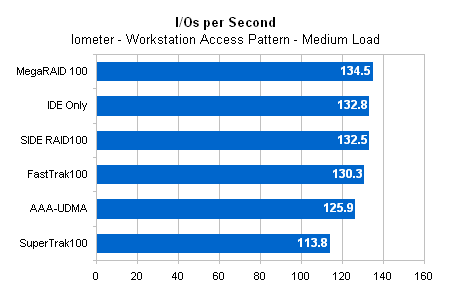
The results are a bit different that we would have though. In this synthetic benchmark, the IDE drive was only beat out by one RAID array: the one powered by the AMI MG80649 controller. The MegaRAID 100 outperformed the non-RAID drive by about 1%. The other RAID drives were beaten by as little as .2% (the SIDE RAID100) and by as much as 17% (SuperTrak100). Lets see how the cards do when in the MBs per second test.
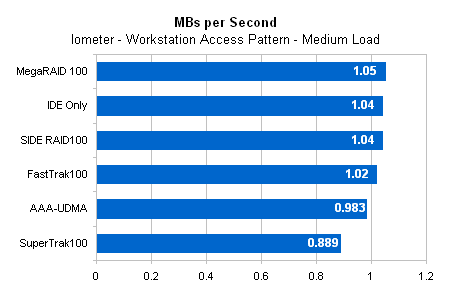
Remember how at the beginning of the test section we discussed how I/Os per second and MBs per second were related? Well this graph goes to prove our point. When switching from I/Os per second to MBs per second, the standings of the cards remain the same. The performance advantage of the MegaRAID 100 here is about 1% again over the IDE drive and the SuperTrak100 maintains 17% performance lag.
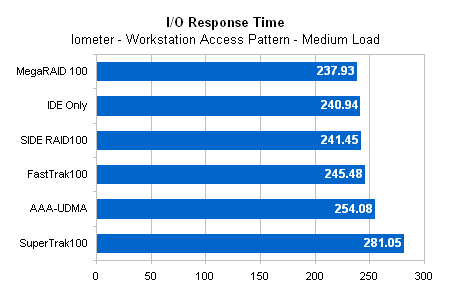
Once again, with the I/O response benchmark, the standings of the cards do not change. In fact, the MegaRAID 100 remains the only card to beat out the standard IDE drive, again by about 1%.
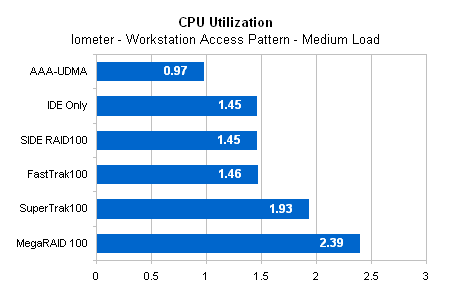
When moving to CPU utilization measures, things change a bit. The MegaRAID 100, which previously beat the other RAID cards and the IDE drive in the other synthetic tests, is now at the bottom of the chart with a massive 2.39% CPU utilization. The hardware based AAA-UDMA does the best in this test with the lowest CPU utilization of all.
As you can see, our RAID performance in the synthetic Iometer benchmark leaves quite a bit to be desired. The highest performance increase we saw over standard IDE was a 1% increase, and that was only in one of the cards. The rest fell below the IDE drive in the graphs, leaving us to wonder what advantage RAID 0 offers.
To put this question to test, we next performed our Content Creation Winstone 2001 benchmark on the arrays tested above. We hoped that the real-world advantage of RAID, one where the CPU is taxed and the disk being written too would be greater than the synthetic advantage we just observed.
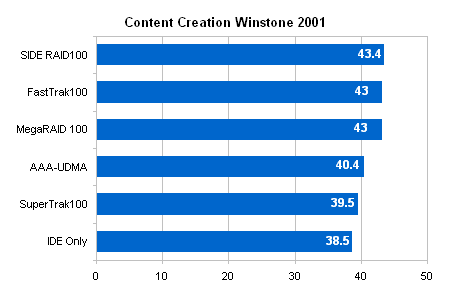
We must admit, it was good to see the above scores when we graphed them for the first time. We were more than a bit worried that even the "fast" RAID 0 did not do anything to performance but hinder it. As our real-world Content Creation Winstone 2001 scores show, RAID 0 does indeed increase performance, and by a noticeable amount.
We found that the fastest card was the Iwill SIDE RAID100, powered by the Highpoint HPT370A. Every RAID 0 array tested was able to outperform the single IDE drive, and in the case of the SIDE RAID100 it was able to do so by a good 13%. The next fastest card, the FastTrak100 and its Promise PDC20267, outperformed the IDE drive by 12%, as did the AMI MG80649 powered MegaRAID 100. The Adaptec hardware RAID card, the AAA-UDMA, performed 5% faster than the pure IDE drive. Finally, the Promise SuperTrak100 hardware RAID card outperformed the IDE drive by 3%.
Obviously, the 12% to 13% performance increase that the software RAID 0 arrays experienced is noticeable. A bit perplexing was the 3% to 5% performance gain that the hardware RAID 0 arrays experienced. To understand why this is, we must refer to the Hardware RAID vs. Software RAID comparison made at the beginning of this article.
If you recall, we showed that all RAID functions, not just the RAID 5 functions, were calculated on the hardware RAID cards. What does this mean in terms of actual performance? Well, it does mean that the system CPU does not have to do as much work. At the same time, it also means that the hardware RAID solutions will perform slower.
The reason for this is that with the high speed of CPU processors available today, like the Duron 850MHz processor used in this review, the CPUs are able to perform the RAID calculations faster than the hardware RAID coprocessors can. It is ture that when moving to RAID 5 the CPU is overburdened with parity bit calculations, but in RAID 0 arrays the CPU has plenty of power to devote to a few simple calculations per clock.
What does this mean to you? Well, if you are a home computer user looking for only a RAID 0 or RAID 1 configuration, there is absolutely no reason to spend the extra money for a hardware RAID card. In fact, you are actually better off performance wise going with a cheaper software RAID solution.
So, we now know that hardware RAID cards are really only good for one thing: RAID 5 configurations. Lets see how our two hardware RAID cards performed in a RAID 5 configuration.










2 Comments
View All Comments
kburrows - Thursday, December 4, 2003 - link
Have you run any tests on any onboard RAID solutions for RAID 0 & 1? I would love to see the results posted for the new SATA RAID on the Intel 875 boards.Anonymous User - Sunday, August 17, 2003 - link
In adressing the performance of an raid array with different stripe sizes, you miss an important factor, namely the accestime of an disk. This wait time has two main couses. First the head positioning and second the rotational latency (the heads track the right trace, but position where the read start has not passed under the head). You may have to wait from 0 to (in the worst case) a full cycle.Since the disks move independently You can calculate that the average latency to get an small file is minimal when the stripe size is about an full cycle of an disk in the array (aprox. 250kB today). All other factors I do know do not reduce this. (controller overhead, transport,...)
So I think that today a minimum stripe size of 256kB should be used.